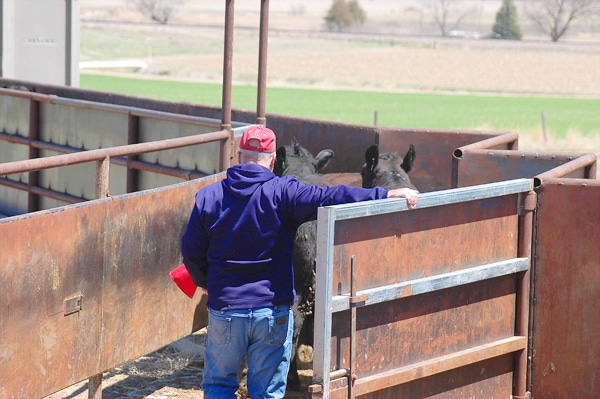Fed cattle prices climb
Winter weather continue to depress cattle performance and help support fed cattle prices.
March 2, 2019

Calf and feeder cattle demand continued to diverge this week as buyers lay in calves destined for grass, while feedlots continue to struggle with tough pen conditions.
“Grazing calves in the Southeast were in demand again this week as ranchers are wanting to get cattle procured so they can be ready to turn out when the first sprig of green grass appears,” said analysts with the Agricultural Marketing Service (AMS).
On the other hand, the AMS reporter on hand for Thursday’s sale at Mitchell Livestock Auction in South Dakota explained, “Cattle feeders are faced with higher cost of gain this winter due to the tough weather and are worried about the impending muddy yards when the warm-up finally comes.”
Earlier in the week, the AMS reporter for Tuesday’s sale at Kingsville Livestock Auction in Missouri noted, “Heavier feedlot-bound cattle found lighter demand over the past few weeks as they are facing the summer-low fed contracts (Live Cattle), and pen conditions have yet to improve through the difficult winter weather.” Steers weighing more than 775 pounds sold $2-$5 lower, while buyers bid as much as $10 higher for grazing-type steers weighing 550-625 pounds.
Nationwide, steers and heifers sold $2 per cwt lower to $1 higher in the North and South Central regions of the country, according to AMS. Prices in the Southeast were $3-$7 higher.
The CME Feeder Cattle Index ended the week at $139.23, the lowest level since June 1.
Week to week on Friday, Feeder Cattle futures closed an average of 75 cents lower through the front three contracts (25 cents lower to $1.67 lower in spot Mar) and then an average of 99 cents higher. The front two contracts were an average of $1.37 lower Friday. Part of the pessimism might have been tied to the increased number of cattle outside feedlots and the notion that some of the supply may be frontloaded.
Estimated feeder cattle supply (cattle outside feedlots) of 26.38 million head was 0.98% more (+255,400 head) than Jan. 1 a year earlier, according to Thursday’s USDA Cattle report (see “More cows-fewer replacements”)
At the same time, despite the second least winter wheat planted area on record, there were 1.9 million head of cattle grazing small grain pastures in Kansas, Oklahoma and Texas Jan. 1. That’s 400,000 more (+26.67%) than the same time last year.
Fed cattle bring $128-$130
Negotiated cash fed cattle trade was another late-week affair, but cattle feeders were rewarded for their patience.
Live trade was $1.50-$3.50 higher Friday at $128-$130 per cwt in the western Corn Belt, $128-$129 in Nebraska and at $128 in the Texas Panhandle, according to the Texas Cattle Feeders Association. Dressed trade was $3 more week to week at $205; a few up to $206 in the western Corn Belt.
Not counting newly minted away-Apr, Live Cattle futures closed an average of 53 cents higher week to week on Friday (15 cents higher to 95 cents higher).
“The April live cattle contract is running more than a $9 premium to the June con-tract and more than a $13 premium to the August contract,” explains Andrew P. Griffith, agricultural economist at the University of Tennessee, in his weekly market comments. “At the same time, the finished cattle market is trading between a negative $1 to negative $2 basis compared to the April contract.
“Considering this scenario, there is a large price gap to fill between now and the June contract. As likely or as unlikely as it may seem that finished cattle prices will decline $9 between April and June, the market could actually have more swing than what is being represented by futures. Steer slaughter the first couple of months of 2019 has been below previous-year levels, which likely means there are more animals waiting in the balance the next few months.”
For perspective, total fed cattle slaughter last year of 25.8 million head was 1.66% more than the previous year (+421,800 head), according to the most recent USDA Livestock Slaughter report. In December, though, fed cattle slaughter was 0.67% less (-13,500 head) than the same time a year earlier.
Incidentally, there was 6.5% more fed heifer slaughter last year than in 2017 (+557,700 head more) at 9.17 million head.
In the meantime, this year’s hard winter will keep the lid on carcass weights, at least for a while. For the week ending Feb. 16, dressed steer weights were 6 pounds lighter than the previous week at 879 pounds.
Compared to the same time a year earlier, they were 4 pounds lighter. Week to week, dressed heifer weights were 3 pounds lighter at 819 pounds, which was 9 pounds lighter than a year earlier.
Choice wholesale beef values were $1.90 higher week to week on Friday at $221.29 per cwt. Select was $4.44 higher at $216.79.
“Middle meats continue to provide the underlying support for the Choice beef cutout, while end cuts, especially the chuck, appear sluggish,” Griffith says. “How much gusto the spring market has will be a good indicator for what the rest of the year has in store.”
Exports key to increasing production
Keep in mind that total domestic meat supplies continue to grow in tandem with beef.
Total beef production of 26.87 billion pounds last year was 2.59% more (+679.6 million pounds) than in 2017. Total red meat production last year of 53.41 billion pounds was 2.73% (+1.42 billion pounds) more than the previous year.
“These production values are expected to increase again in 2019 with the expected increase in slaughter levels,” Griffith explains. “The question is how will the market react to increased red meat production? The hope is that domestic demand remains strong and that favorable trade agreements are established to continue moving beef and pork internationally.”
U.S. beef exports continue to shine, shattering previous records for volume and value through November. Beef export value per head of fed slaughter for the first 11 months of the year was $320.72, which was 14% more than the previous year.
USDA’s Economic Research Service (ERS) projects U.S. beef exports to bring $100 million more in value this year at $7.7 billion.
“Livestock, dairy, and poultry export forecasts are raised $300 million to $30.4 billion, largely as gains in beef, pork, poultry, dairy, and other products offset declines for hides, skins, and furs,” ERS analysts say in the latest Outlook for U.S. Agricultural Trade. “The beef forecast is raised on sustained demand despite stronger prices.”
About the Author(s)
You May Also Like





